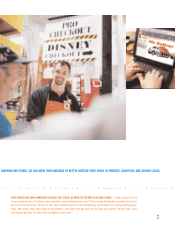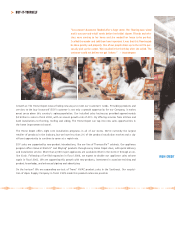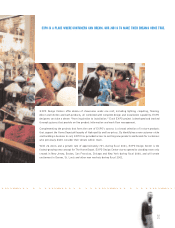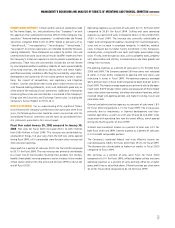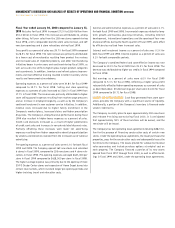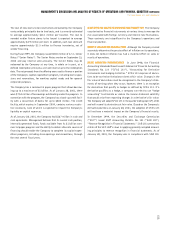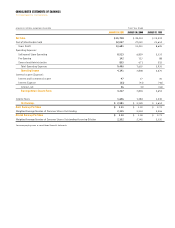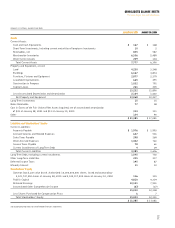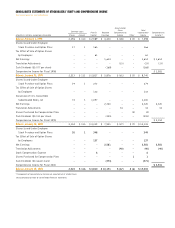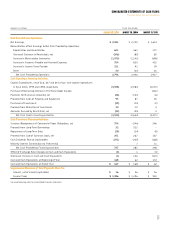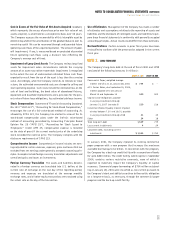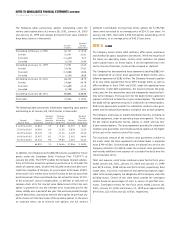Home Depot 2000 Annual Report Download - page 21
Download and view the complete annual report
Please find page 21 of the 2000 Home Depot annual report below. You can navigate through the pages in the report by either clicking on the pages listed below, or by using the keyword search tool below to find specific information within the annual report.
Management’s Discussion and Analysis of Results of Operations and Financial Condition (continued)
The Home Depot, Inc. and Subsidiaries
18
19
The cost of new stores to be constructed and owned by the Company
varies widely, principally due to land costs, and is currently estimated
to average approximately $14.1 million per location. The cost to
remodel and/or fixture stores to be leased is expected to average
approximately $4.9 million per store. In addition, each new store will
require approximately $3.5 million to finance inventories, net of
vendor financing.
During fiscal 1999, the Company issued $500 million of 6 1⁄2% Senior
Notes (“Senior Notes”). The Senior Notes are due on September 15,
2004 and pay interest semi-annually. The Senior Notes may be
redeemed by the Company at any time, in whole or in part, at a
defined redemption price plus accrued interest up to the redemption
date. The net proceeds from the offering were used to finance a portion
of the Company’s capital expenditure program, including store expan-
sions and renovations, for working capital needs and for general
corporate purposes.
The Company has a commercial paper program that allows borrow-
ings up to a maximum of $1 billion. As of January 28, 2001, there
were $754 million of borrowings outstanding under the program. In
connection with the program, the Company has a back-up credit facil-
ity with a consortium of banks for up to $800 million. The credit
facility, which expires in September 2004, contains various restric-
tive covenants, none of which is expected to impact the Company’s
liquidity or capital resources.
As of January 28, 2001, the Company had $167 million in cash and
cash equivalents. Management believes that its current cash position,
internally generated funds, funds available from its $1 billion com-
mercial paper program and the ability to obtain alternate sources of
financing should enable the Company to complete its capital expen-
diture programs, including store openings and renovations, through
the next several fiscal years.
Quantitative and Qualitative Disclosures About Market Risk The Company
uses derivative financial instruments at various times to manage the
risk associated with foreign currency and interest rate fluctuations.
These contracts are insignificant to the Company’s operations and
financial position.
Impact of Inflation and Changing Prices Although the Company cannot
accurately determine the precise effect of inflation on its operations,
it does not believe inflation has had a material effect on sales or
results of operations.
Recent Accounting Pronouncements In June 1998, the Financial
Accounting Standards Board issued Statement of Financial Accounting
Standards No. 133 (“SFAS 133”), “Accounting for Derivative
Instruments and Hedging Activities.” SFAS 133 requires all deriva-
tives to be carried on the balance sheet at fair value. Changes in the
fair value of derivatives must be recognized in the Company’s state-
ments of earnings when they occur; however, there is an exception
for derivatives that qualify as hedges as defined by SFAS 133. If a
derivative qualifies as a hedge, a company can elect to use “hedge
accounting” to eliminate or reduce the income statement volatility
that would arise from reporting changes in a derivative’s fair value.
The Company will adopt SFAS 133 in the quarter ending April 29, 2001
and will record its derivatives at fair value. Based on the Company’s
derivative positions at January 28, 2001, the adoption of SFAS 133
will not have a material impact on the Company’s financial results.
In December 1999, the Securities and Exchange Commission
(“SEC”) issued Staff Accounting Bulletin No. 101 (“SAB 101”),
“Revenue Recognition in Financial Statements.” SAB 101 summarizes
certain of the SEC staff’s views in applying generally accepted account-
ing principles to revenue recognition in financial statements. As of
January 28, 2001, the Company was in compliance with SAB 101.


